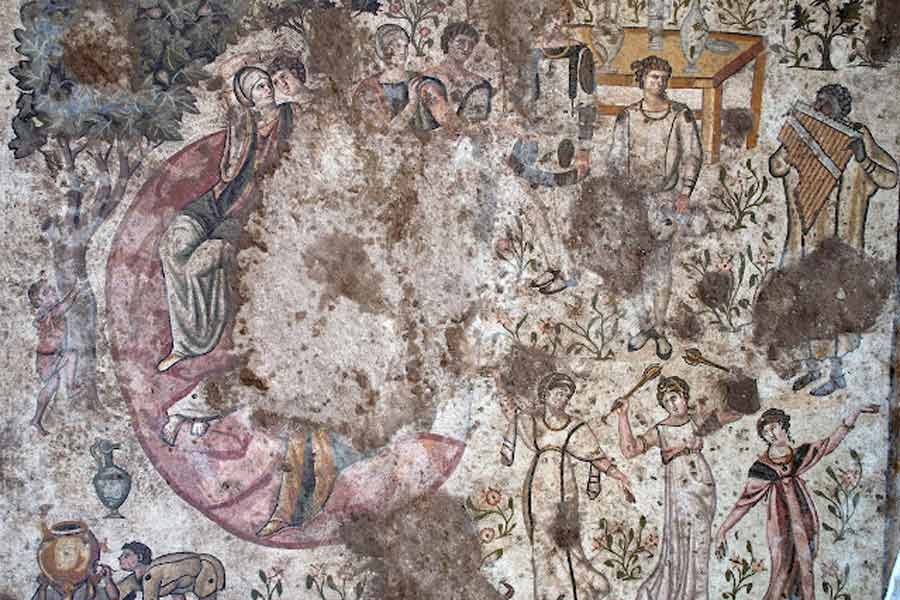Mosaic Depicts 1,500-Year-Old Roman Party Scene
Archaeologists have found the remains of 1500-year-old architectural structures, baths, and a mosaic during the seventh stage of excavations in the ancient city of Germanicia in Turkey’s southeastern province of Kahramanmaraş. The mosaic, measuring 50 square meters (538 square feet), depicts an open-air feast with three women dancing and enjoying themselves to music, potentially a ‘pre-hunt’ celebration, reports Daily Sabah.
An Open-Air Banquet as a Pre-Hunt Ritual?
Kahramanmaraş Museum Director Safinaz Acıpayam says, “During the excavations, a 50 square-metre mosaic, which is the continuation of the previous mosaic we discovered, was found. Some architectural structures and remains of baths were found in the same area. The mosaic is a truly magnificent one. We think it is depicting an open-air banquet. We unearthed a mosaic, consisting of two panels, during our excavations in 2015, and there were hunting scenes on this mosaic.”

Archaeologists work on the Roman mosaic at the ancient city of Germanicia, Kahramanmaraş, southern Turkey. (DHA Photo)
“The panel we found during the 2021 excavations is actually a continuation of this mosaic from 2015, and we think it was probably an open-air banquet before the hunt. There are two couples sitting in the centre and three women dancing to the music. There are also two male figures making presentations. There is also the figure of a barefoot little boy climbing a fig tree,” she said.
- Roman Mosaic Depicting The Illiad Discovered in “Oh Wow Moment”
- New Date for Chedworth Roman Villa Mosaic Changes English History

A close-up of the women dancing on the Roman mosaic discovered at the ancient city of Germanicia, Kahramanmaraş, southern Turkey. (DHA Photo)
A Turbulent History of a Proud City
Over the past decade, archaeologists have been exploring the ancient city, which is spread out over a 140-hectare area layered underneath a modern suburb. It was discovered accidentally in 2007 as a result of illegal excavations. The ancient city changed hands many times – from the Hittites (all the way back to 1600 BC) to the Urartians, Assyrians, Persians, Macedonians, and the Seleucid kings. It was conquered by the Romans, who renamed it Germanicia Caesarea, in honor of Emperor Gaius Caesar Augustus Germanicus, reports Dig Ventures.
Eventually, the Arabs took control in 645 – they called it Marash. However, during the Arab-Byzantine wars, popularly known as ‘The Crusades’, the city was destroyed several times over. It was also struck by natural disaster – very severe landslides buried the city below the ground, where it remained hidden for nearly 1,500 years! Despite knowledge of the existence of the city, there was no inkling about how to find it.

Aerial photo of the excavation area. (DHA photo)
After the illegal excavations of 2007, the Turkish Ministry of Culture and Tourism reclaimed the land with the Kahramanmaraş Museum carrying out intense repair work. The archaeological team believes that the mosaic is part of a 3-series panel of a pre-hunt scene – 2 of these 3 panels were found in 2015. Acıpayam added that archaeological remains have been identified in 35 areas within the boundaries of the old city, 7 of which have been explored under the aegis of the museum.
- Aquincum: Exploring the Ancient Roman City Under Modern-day Budapest
- One of the Best Roman Mosaics Found in the UK will be Reburied
Elite Residences of the Roman Elite
From this, a total of 20 mosaics have been discovered, potentially linked to Roman villas inhabited by the local elite and military leaders. These villas were built into the sides of hills, providing the dual purpose of improved property surveillance and access to a cool mountain breeze during the summer months.
In total, there are over 100 residences, with each having several interconnected rooms and mosaics dating to the Late Roman Period, i.e., the 4th-6th century AD. Further excavations are planned in the same area throughout the year, as well as public openings for visitors to see the finds in the future.
Moving Forward
Stating that the excavations will continue in the area where the mosaic is located, Acıpayam concluded, “Excavations have not been carried out in the entire area, we plan to continue the excavations in the same area in 2022. At the end of 2022, we plan to open the area, where the excavations were carried out, in line with the permissions of the General Directorate of Cultural Heritage and Museums. We would like to thank the Culture and Tourism Ministry and all institutions for their support.”
Top image: The 1,500-year-old Roman mosaic depicting people enjoying a pre-hunt party. Source: DHA
By Sahir Pandey
References
ANN. 2022. Late Roman Mosaic Depicting Feast Found In Caesarea Germanicia In Southeastern Turkey. Available at: https://archaeologynewsnetwork.blogspot.com/2022/02/late-roman-mosaic-depicting-feast-found.html.
DNA. 2022. 1,500-year-old mosaic depicting feast found in Turkey's Germanicia. Available at: https://www.dailysabah.com/arts/1500-year-old-mosaic-depicting-feast-found-in-turkeys-germanicia/news.
DNA. 2022. Party like it's 522: 1,500-year-old feast mosaic found in Turkey. Available at: https://www.dailysabah.com/gallery/party-like-its-522-1500-year-old-feast-mosaic-found-in-turkey/images.
Duvar, E. 2022. 1500-year-old mosaic found in ancient city of Germanicia in southeastern Turkey. Available at: https://www.duvarenglish.com/1500-year-old-mosaic-found-in-ancient-city-of-germanicia-in-southeastern-turkey-news-60269.
HDN. 2022. Mosaic depicts open-air banquet. Available at: https://www.hurriyetdailynews.com/mosaic-depicts-open-air-banquet-171157.
Pina-Dacier, M. 2022. 1,500 year-old mosaic of three women dancing found in Turkey’s ancient city of Germanicia. Available at: https://digventures.com/2022/02/1500-year-old-mosaic-of-three-women-dancing-found-in-turkeys-ancient-city-of-germanicia/.

















